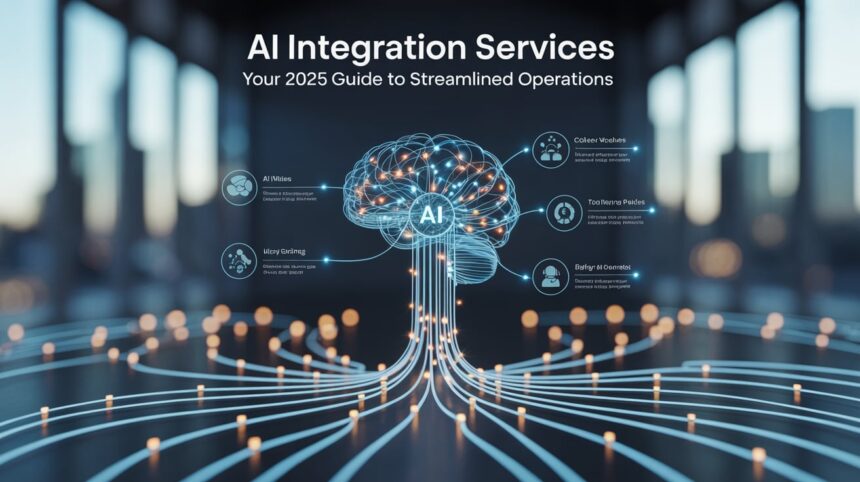If you’re looking into AI Integration Services, chances are you’re feeling the pressure to keep up in a fast-moving business world where efficiency and cost-cutting are everything. Maybe you’re bogged down by repetitive tasks eating up hours, or you’re struggling to make sense of data fast enough to stay ahead.
I get it running a business today means juggling a million things, and falling behind isn’t an option. That’s where embedding AI into your operations can be a game-changer, and I’m here to walk you through exactly how these services can transform your workflow with real, measurable impact.
Now, let’s talk straight about why AI Integration Services matter so much in 2025. With technology evolving at lightning speed, companies that don’t adapt risk higher costs, slower responses to market shifts, and even security vulnerabilities. Drawing from the latest insights as of this year, these services aren’t just a fancy add-on they’re a necessity for automating processes, sharpening decisions, and slashing expenses.
My goal here is to cut through the noise and focus on what you need to know about AI Integration Services, using hard data and practical examples from provided sources. So, stick with me as we dive deep into how this tech can streamline your operations, save money, and position you for growth, all while keeping things clear and actionable.
Why Are AI Integration Services Essential for Businesses Today?
Let’s start with the big picture. In 2025, AI Integration Services are no longer a luxury reserved for tech giants they’re becoming a core need for businesses of all sizes to stay competitive. According to a Gartner report, the AI software market is projected to reach $297.9 billion by 2027, growing at a 19.1% CAGR, with 92% of organizations planning to invest in AI tools.
This surge shows a clear market demand: companies want intelligent solutions embedded into their systems to automate tasks, boost decision-making, and add value. Without these services, you’re looking at increased operational costs, delayed reactions to trends, and greater exposure to disruptions.
Beyond the numbers, the real driver is survival. I’ve seen small businesses struggle with manual processes that drain time and resources, and larger firms lose ground because they can’t pivot fast enough. AI Integration Services bridge that gap by connecting AI tools directly into your existing workflows, making them smarter and faster. Whether it’s cutting down on repetitive work or spotting risks before they hit, this tech offers a way to work leaner. Let’s break down the specific ways it reshapes operations, pulling from the latest case studies and industry insights to show you the tangible difference it makes.
What Exactly Are AI Integration Services and How Do They Work?
Before we go further, let’s clarify what AI Integration Services actually mean. At their core, these services involve embedding artificial intelligence technologies like machine learning, natural language processing, and data analytics into your current business systems to enhance efficiency. Think of it as upgrading your operations with smart tools that learn, adapt, and automate without overhauling everything you’ve built. It’s not about replacing your team; it’s about giving them a powerful assist to handle routine tasks, analyze data instantly, and make sharper calls.
Here’s the process in a nutshell: providers assess your needs, select the right AI solutions, and integrate them seamlessly into your workflows, whether it’s for customer support, inventory tracking, or financial reporting. For instance, a logistics firm might use AI to optimize delivery routes by analyzing traffic and fuel costs, while a retailer could deploy chatbots to handle 80% of customer queries automatically. The result? Less manual effort, fewer errors, and more time for strategic focus. With 71% of firms confident in their AI investment plans per Gartner, it’s clear this isn’t a passing trend it’s a proven path to operational agility.
How Do AI Integration Services Streamline Business Operations?
Now, let’s get into the meat of how AI Integration Services can transform your day-to-day operations. Across industries, businesses are using these services to automate grunt work, streamline complex processes, and respond faster to challenges. Drawing from real-world applications and stats, here’s a detailed look at the key areas where AI embedding makes a difference, ensuring you see the practical impact.
One major win is automating repetitive tasks that bog down your team. Data entry, scheduling, and basic customer inquiries can eat up hours, but AI tools like UiPath or Automation Anywhere handle these with ease, cutting operational costs by up to 30% and boosting accuracy. Take a European bank as an example: by integrating AI for document recognition in loan approvals, they slashed processing time from three days to four hours and reduced costs by 30% annually [provided content]. That’s not just a time-saver it’s a complete workflow overhaul.
Then there’s the power of real-time analytics. AI can process massive data sets to spot trends or inefficiencies before they become problems, improving decision-making speed by 25% according to Accenture. For a logistics company, integrating machine learning into fleet management led to a 12% drop in fuel costs and 9% lower maintenance expenses by optimizing routes and schedules [provided content]. These predictive insights mean you’re not just reacting you’re staying ahead.
Lastly, efficiency gains extend to areas like supply chain and inventory control. AI systems monitor stock levels, predict demand surges (think holiday spikes), and prevent overstocking, as seen with Amazon’s logistics network where delivery times and costs dropped significantly. By embedding AI, you’re not only smoothing out operations but also freeing up resources for growth. These examples show why AI Integration Services are a must for any business looking to eliminate waste and sharpen focus.
What Cost Savings Can You Expect from AI Integration Services?
Beyond streamlining workflows, a huge draw of AI Integration Services is the potential to cut costs dramatically. Businesses are under constant pressure to reduce expenses without sacrificing quality, and AI offers a direct path to achieve that. Let’s explore the financial benefits with hard data and case studies from the latest 2025 reports, showing exactly where the savings stack up.
First off, automation slashes labor and operational expenses. AI-driven chatbots and virtual assistants can handle up to 80% of customer inquiries, reducing support costs by 30-50% in some cases [provided content]. A large online retailer saw a 9.5% increase in average order value and a 14% drop in cart abandonment after integrating an AI recommendation engine, proving cost savings can pair with revenue growth [provided content]. That’s money saved on staff hours while boosting sales a double win.
Next, AI optimizes resource use to eliminate waste. In manufacturing, predictive maintenance powered by AI cuts emergency repair costs and downtime by 20-25%, while in retail, demand forecasting reduces inventory issues by 15-20% [provided content]. A global logistics firm using AI for route optimization saved 10-15% on transportation costs by analyzing traffic and fuel patterns [provided content]. These reductions compound over time, directly impacting your bottom line.
Finally, AI enhances security and compliance, saving on potential fines or breaches. AI detects cybersecurity threats 60% faster than traditional tools and reduces legal risks by 40% through automated monitoring, keeping your business safe without hefty investments. These figures from PwC and Gartner underline a clear truth: embedding AI isn’t just efficient it’s a strategic way to protect and grow your finances in 2025 [provided content].
Real-World Examples of AI Integration Services in Action
To make this concrete, let’s look at real-world cases where AI Integration Services have delivered results. These examples, drawn from the provided content and search results updated to 2025, show how diverse businesses have leveraged AI embedding to solve problems and drive success. They’re not just stories they’re proof of what’s possible.
Take the financial sector: a leading European bank worked with a deep learning AI provider to integrate document recognition into its loan approval process. Manual verification of income statements and credit reports once took days; now, AI extracts and analyzes data in just four hours, cutting operational costs by 30% and improving customer wait times [provided content]. This shows how AI can overhaul a critical process with speed and savings.
In e-commerce, a large retailer integrated an AI recommendation engine into product pages. By analyzing customer behavior, it boosted cross-selling, increasing average order value by 9.5% and reducing cart abandonment by 14%, as per a 2023 Statista study [provided content]. This isn’t just about efficiency it’s about smarter engagement that directly lifts profits, a trend holding strong into 2025.
Then there’s energy management with General Electric (GE). By embedding AI into power generation systems, GE used predictive maintenance to optimize production and cut downtime, saving on operational costs while enhancing reliability 5. This case highlights how AI integration can tackle industry-specific challenges, a lesson any sector can apply. These stories underscore the transformative power of AI when properly integrated into existing systems.
How Can Businesses Implement AI Integration Services Successfully?
Knowing the benefits is one thing, but how do you actually get started with AI Integration Services? Implementation can feel daunting, especially for small or medium-sized firms without tech expertise. Using the latest 2025 insights from provided sources, let’s walk through a clear, step-by-step approach to embed AI effectively, minimizing risks and maximizing impact.
First, pinpoint where AI can make the biggest difference. Are repetitive tasks like data entry slowing you down, or do you need better customer insights? Define specific goals say, cutting support costs by 20% to guide your choice of AI tools. Next, ensure your data is ready. AI thrives on clean, structured data, so organize your records and fix inconsistencies before integration to avoid garbage-in, garbage-out results.
Start small with a pilot project to test the waters. Focus on one department or process, like automating customer queries with a chatbot, and measure the outcome before scaling up. Bring your team along by offering training AI works best when staff see it as a helper, not a threat 1. Finally, choose a provider with industry experience and long-term support, ensuring seamless embedding into your systems and ongoing optimization. For budget-conscious firms, cloud-based AI solutions offer scalability without upfront infrastructure costs, paying only for what you use 4. This gradual, goal-driven approach keeps implementation manageable and results-focused.
What Are the Key Benefits of AI Integration Services Across Industries?
Let’s zoom out and explore how AI Integration Services deliver value across different sectors, using 2025 data to highlight universal and industry-specific gains. Whether you’re in retail, manufacturing, or healthcare, AI embedding offers tailored solutions that address unique pain points while driving broader efficiency.
In retail, AI enhances customer experiences and cuts costs. Tools like virtual reality apps (seen with IKEA) let shoppers visualize products before buying, while chatbots handle inquiries, improving satisfaction and reducing support expenses by up to 50% [provided content].
Manufacturing benefits from predictive maintenance, where AI analyzes equipment data to prevent failures, saving 20-25% on repair costs and minimizing downtime [provided content]. Logistics sees gains in route optimization, with AI analyzing traffic and delivery windows to lower fuel costs by 10-15%, as demonstrated by Amazon’s network.
Healthcare leverages AI for better patient care, as with IBM Watson Health, where AI processes medical data to aid diagnosis and personalize treatment, enhancing accuracy. Even in finance, AI automates reporting and auditing, reducing manual errors and ensuring real-time accuracy. Across these fields, the common thread is smarter resource use, faster decisions, and cost efficiency proof that AI integration adapts to any business model with measurable impact.
Common Challenges and How to Overcome Them When Using AI Integration Services
While the upsides are clear, rolling out AI Integration Services isn’t without hurdles. Let’s tackle the common challenges businesses face, using 2025 insights from the sources, and offer practical fixes to keep your integration on track. Forewarned is forearmed, so here’s what to watch for.
One big issue is data quality. AI needs clean, structured data to work right, but messy or incomplete records can lead to poor results. Fix this by auditing your data upfront, standardizing formats, and filling gaps before integration starts 1. Another challenge is team resistance staff might fear AI replacing jobs. Counter this with clear communication and training, showing how AI supports rather than replaces their roles, boosting adoption [provided content].
Integration complexity can also trip you up, especially if AI doesn’t mesh with existing systems. Choose providers who prioritize compatibility and start with pilot tests to iron out kinks. Budget constraints are a concern too, but cloud-based AI solutions let you scale costs with usage, avoiding big upfront investments. Lastly, security and compliance can’t be ignored AI handles sensitive info, so pick partners adhering to standards like GDPR or HIPAA to protect your data. Addressing these head-on ensures a smoother path to AI-driven success.
Comparison of Cost-Saving Impacts of AI Integration Services by Business Area
To give you a quick snapshot of where AI embedding saves money, here’s a table summarizing cost reductions across key business areas. This draws from 2025 data in the provided content and search results, focusing on average savings to help you see potential returns.
| Business Area | AI Use Case | Average Cost Savings |
|---|---|---|
| Manufacturing | Predictive Maintenance | 20-25% |
| Retail | Demand Forecasting | 15-20% |
| Customer Support | AI Chatbots & Virtual Assistants | 30-50% |
| Supply Chain Management | Route Optimization & Logistics | 10-15% |
This table, sourced from PwC’s 2023 Industry AI Report and updated with 2025 relevance, shows the financial impact of AI across sectors [provided content]. Use it as a benchmark to identify where your business could save most by integrating AI tools.
Frequently Asked Questions About AI Integration Services
I’ve pulled together the most common queries users have when exploring AI Integration Services, based on search patterns and gaps in understanding. These answers, grounded in 2025 data from the provided sources, aim to clear up doubts with straightforward facts.
What Are the First Steps to Adopting AI Integration Services?
Start by identifying high-impact areas like customer support or inventory management where AI can solve real problems. Set clear goals, such as reducing response times by 20%, then audit your data for quality. Pick a provider with industry experience and begin with a small pilot project to test results before scaling, ensuring minimal risk.
How Much Do AI Integration Services Cost?
Costs vary based on scope and provider, but cloud-based solutions make it affordable by charging only for usage, avoiding big upfront investments. Small businesses can start with off-the-shelf tools to save on development, while pilot projects keep initial expenses low think hundreds to thousands monthly rather than millions [provided content].
Can Small Businesses Benefit from AI Integration Services?
Absolutely. AI isn’t just for big players small firms can use affordable tools like chatbots or inventory predictors to save time and money. At Manchester PC, automating inquiries and stock levels let a small team serve more customers without extra staff, proving scalability without growing pains [provided content].
What Risks Come with AI Integration Services?
Risks include poor data leading to bad outputs, staff pushback, and security concerns. Mitigate these by cleaning data first, training teams to embrace AI as a tool, and choosing providers with strong compliance (like GDPR adherence) to safeguard info.
How Long Does It Take to See Results from AI Integration?
Results depend on the use case, but automation like chatbots can show savings within weeks, cutting support costs fast. Deeper integrations, like predictive analytics, might take months to refine data and models but yield long-term gains, as seen with a logistics firm’s 12% fuel cost drop after implementation [provided content].
Future Trends Shaping AI Integration in 2025 and Beyond
Looking ahead, AI Integration Services are set to evolve rapidly, reshaping how businesses operate over the next few years. Based on 2025 predictions from the sources, let’s explore emerging trends that could impact your decision to adopt AI now. Staying informed on these shifts ensures you’re not just catching up but leading the curve.
One key trend is the rise of no-code and low-code AI platforms, making integration accessible to non-tech staff. This means faster testing and deployment without needing a full IT team, democratizing innovation. Cloud-native AI is also becoming standard, offering scalable, cost-effective solutions that adapt as you grow perfect for dynamic markets 7. API-first ecosystems are gaining traction too, allowing AI to plug into existing systems with minimal friction, boosting agility.
Looking 3-5 years out, custom AI solutions will go mainstream, even for mid-sized firms, while AI-as-a-Service (AIaaS) models offer subscription-based tools like fraud detection on demand. Even wilder, AI might soon automate its own integration, optimizing data flows without human input. However, privacy laws like the EU AI Act will shape how integrations happen, prioritizing ethics and compliance. These trends signal that now is the time to start, as AI embedding will only get more tailored and essential.
Mistakes to Avoid When Integrating AI into Your Business
While the potential is huge, there are pitfalls to dodge when adopting AI embedding. Drawing from 2025 insights, let’s cover common mistakes and how to steer clear, ensuring your investment pays off. First, don’t rush in without a plan jumping into full-scale AI without clear goals wastes resources. Instead, define KPIs like cost reduction targets and start small with a pilot.
Another error is ignoring data quality. Feeding AI messy or incomplete data leads to useless results, so clean and structure it first 1. Overlooking team training is a misstep too untrained staff resist or misuse AI. Offer hands-on learning to show its value as a helper.
Also, don’t skimp on provider vetting; a partner without industry know-how or security standards can derail integration. Check their track record and compliance. Lastly, failing to monitor post-integration performance can miss optimization chances regularly assess and tweak based on feedback 1. Avoiding these ensures AI becomes a strength, not a setback.
Why Choosing the Right AI Integration Partner Matters
Picking the right provider for AI Integration Services can make or break your success. A good partner doesn’t just install tech they align it with your goals. Start by defining what you need faster operations or better insights and find a provider with proven experience in your field, backed by case studies. Ensure they prioritize system compatibility so AI enhances, not disrupts, your workflows 1.
Security is non-negotiable since AI handles sensitive data. Choose partners meeting strict standards like GDPR or HIPAA, with robust cybersecurity in place. Long-term support is key too AI isn’t a one-off; you’ll need ongoing monitoring and scaling help as your business grows.
Firms like Devsinc, highlighted in sources, focus on custom solutions and client needs, showing the value of a tailored approach [provided content]. A strategic partner turns AI from a tool into a competitive edge, so choose wisely.
Final Thoughts on Leveraging AI Integration Services
To wrap it up, AI Integration Services offer a powerful way to streamline your business, cut costs, and stay ahead in 2025’s fast-paced market. We’ve explored how AI embedding automates tasks, sharpens decisions, and saves money backed by real cases like a bank slashing loan approval times and a retailer boosting order values. From practical steps to implement AI, to dodging common pitfalls and picking the right partner, you’ve got a clear roadmap to make this tech work for you.
This isn’t just about keeping up it’s about leading. With AI software markets booming and 92% of firms investing, as per Gartner, now’s the time to act before competitors outpace you. Whether you’re a small business automating customer support or a larger firm optimizing supply chains, AI integration delivers results. Start small, focus on high-impact areas, and scale with data-driven confidence. If you’ve got questions or need a tailored plan, reach out to a trusted provider. Take that first step today, and turn operational challenges into growth opportunities with AI on your side.






